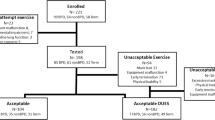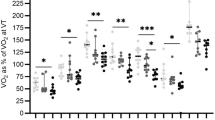Abstract
Fifteen very low birth weight children, 9 appropriate for gestational age (AGA, mean birth weight 1302 ± 164 g) and 6 small for gestational age children (SGA, mean birth weight 1263±117 g), were studied at the age of 7–12 years, and compared to a group of 26 healthy, age-, sex-, and height-matched children born at term. None of the VLBW children had developed chronic bronchopulmonary disease. Pulmonary function tests and progressive exercise tests on a treadmill were performed. Forced vital capacity, forced expiratory volume at 1 s and forced expiratory flow between 25% and 75% of vital capacity were normal for all subjects. No differences were found in maximum oxygen consumption, anaerobic threshold and maximal heart rate between the AGA and SGA children and the respective controls. Both in the AGA and SGA subgroups, the pre-exercise oxygen uptake results were comparable to those of the controls. In the SGA subgroup the energy cost of running was significantly higher with respect to the controls, while no difference was found between the AGA and the control children. In conclusion, children with birth weight less than 1501 g have normal values of aerobic fitness. In SGA children the efficiency of running is slightly reduced.
Similar content being viewed by others
Abbreviations
- AGA:
-
appropriate for gestational age
- EC:
-
energy cost
- HR:
-
heart rate
- SGA:
-
small for gestational age
- VAT:
-
anaerobic ventilatory threshold
- \(\dot V\)CO2 :
-
carbon dioxide output
- VLBW:
-
very low birth weight
- \(\dot V\)O2 :
-
oxygen uptake
References
Allen MC (1984) Developmental outcome and follow up of the small for gestational age infant. Semin Perinatol 8: 123–156
Andreasson B, Lindroth M, Mortensson W, Svenningsen NW, Johnson B (1989) Lung function eight years after neonatal ventilation. Arch Dis Child 64: 108–113
Bader D, Ramos AD, Lew CD, Platzker ACG, Stabile MW, Keens TG (1987) Childhood sequelae of infant lung disease: exercise and pulmonary function abnormalities after bronchopulmonary dysplasia. J Pediatr 110: 693–699
Bar-Or O (1983) Pediatric sports medicine for the practitioner. Springer, Berlin Heidelberg New York
Caiozzo VS, Davis JA, Ellis JF, Azus JL, Vandagriff R, Prietto CA, McMaster WC (1982) A comparison of gas exchange indices used to detect the anaerobic threshold. J Appl Physiol 53: 1184–1189
Cooper DM, Hyman CB, Weiler-Ravel D, Noble NA, Agness CL, Wasserman K (1985) Gas exchange during exercise in children with thalassemia major and Diamond-Blackfan anemia. Pediatr Res 19: 1215–1219
Davies CTM (1980) Metabolic cost of exercise and physical performance in children with some observations on external loading. Eur J Appl Physiol 45: 95–102
Haltia M, Berlin O, Schucht H, Sourander P (1978) Postnatal differentiation and growth of skeletal muscle fibers in normal and undernourished rats. J Neurol Sci 36: 25–39
Heldt GP, McIlroy MB, Hansen TN, Tooley WH (1980) Exercise performance of the survivors of hyaline membrane disease. J Pediatr 96: 995–999
Lamarre A, Linsao L, Reilly BJ, Swier PR, Levison H (1973) Residual pulmonary abnormalities in survivors of idiopathic respiratory distress syndrome. Am Rev Respir Dis 108: 56–61
Lubchenco LO, Hansman C, Boyd E (1966) Intrauterine growth in length and head circumference as estimated from live births at gestational ages from 26–42 weeks. Pediatrics 37: 403–408
Mansell AL, Driscoll JM, James LS (1978) Pulmonary followup of moderately low birth weight infants with and without respiratory distress syndrome. J Pediatr 110: 111–115
Marlow N, Roberts BL, Cooke RWI (1989) Motor skills in extremely low birthweight children at the age of 6 years. Arch Dis Child 64: 839–847
Olgiati R, Jacquet J, Prampero PE di (1986) Energy cost of walking and external dyspnea in multiple sclerosis. Am Rev Respir Dis 134: 1005–1010
Polgar G, Promadhat V (1974) Pulmonary function testing in children: techniques and standards. W. B. Saunders, Philadelphia
Prampero PE di (1985) La locomozione umana su terra, in acqua, in aria. Edi-Ermes, p 78
Prampero PE di (1986) The energy cost of human locomotion on land and in water. Int J Sports Med 7: 55–72
Scott DT (1987) Premature infants in later childhood: some recent follow-up studies. Semin Perinatol 11: 191–199
Smith DW (1977) Growth and its disorder. WB Saunders, Philadelphia
Stahlman M, Hedvall G, Lindstrom D, Snell J (1982) Role of hyaline membrane disease in production of later childhood lung abnormalities. Pediatrics 69: 572–576
Tanner JM, Whitehouse RH, Takaishi M (1966) Standards from birth to maturity for height, weight, height velocity and weight velocity: British childre, 1965. Arch Dis Child 41: 454–471
Teberg JA, Walther FJ, Pena IC (1988) Mortality, morbidity and outcome of the small for gestational age infant. Semin Perinatol 12: 84–94
Touwen BCL, Hadders-Algra M, Huijes HI (1988) Hypotonia at six years in prematureley-born or small-for-gestational-age children. Early Hum Dev 17: 79–88
Wasserman K, Whipp BJ, Koyal SN, Beaver WL (1973) Anaerobic threshold and respiratory gas exchange during exercise. J Appl Physiol 55: 236–243
Wasserman K, Hansen JE, Sue DJ, Whipp BJ (1987) Principles of exercise testing and interpretation. Lea and Febiger, Philadelphia
Zanconato S, Baraldi E, Santuz PA, Vido L, Rigon F, Da Dalt L, Zacchello F (1989) Gas exchange during exercise in obese children. Eur J Pediatr 148: 614–617
Author information
Authors and Affiliations
Rights and permissions
About this article
Cite this article
Baraldi, E., Zanconato, S., Zorzi, C. et al. Exercise performance in very low birth weight children at the age of 7–12 years. Eur J Pediatr 150, 713–716 (1991). https://doi.org/10.1007/BF01958761
Received:
Accepted:
Issue Date:
DOI: https://doi.org/10.1007/BF01958761




